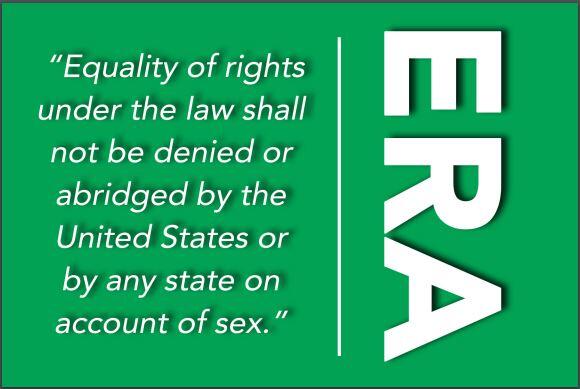Jan. 7, 2019
Q&A: Will Virginia ratify the Equal Rights Amendment?
Share this story
In the upcoming General Assembly session, Virginia could become the 38th and final state needed to ratify the Equal Rights Amendment, which would guarantee equal legal rights for all American citizens regardless of sex and would end legal distinctions between men and women in terms of divorce, property, employment and other matters.

The proposed constitutional amendment, also known as the ERA, was first introduced in Congress in 1923 and ultimately approved in 1972, sending it to the states for ratification. By 1977, 35 states had approved it, three short of the needed three-quarters of states. Nevada ratified it in 2017, followed by Illinois in 2018. Advocates see Virginia as a strong possibility for the ERA’s final ratification.
Deirdre Condit, Ph.D., an associate professor in the Department of Political Science and associate dean of faculty affairs for the College of Humanities and Sciences, is an expert on women and politics. She recently discussed the ERA, its history and the politics surrounding the nearly centurylong movement to see it added to the Constitution.
The Equal Rights Amendment would guarantee equal legal rights for all American citizens regardless of sex. What sort of changes would it lead to? How would it impact people's lives?
First, the premise of the question is problematic. I would argue that formal constitutional recognition of the equality of persons before the law, regardless of sex, is itself inherently a worthwhile objective. Since the founding of the nation, sex has been a fundamental characteristic used either to include or exclude persons from the full protection of our laws. Finally eradicating that arbitrary distinction as a means for doing so is inherently in keeping with the values of the country.
Second, it is important to remember that the United States is not legally bound to enact the basic principles of equality based on sex; rather, the court has settled on a less bright line for determining when a law violates the 14th Amendment’s requirement for equal protection.
Without explicit constitutional language, the court repeatedly must resort to an intermediate or more attenuated standard in cases of sex-based differential treatment than it uses in cases such as race discrimination. This means that the court is continually required to go back and revisit questions about a variety of issues, asking itself: “Is this treatment of women (or men) as different OK this time? Or not?” Inclusion of the ERA in the U.S. Constitution would provide them a more concrete answer.

Moreover, most of the current “equality” afforded women and men has come as a result of court decisions and statutory changes; it’s important to remember that what was done by one court can be undone by another. Laws passed by one set of legislators can be revoked by a subsequent one. Changing the Constitution by amending it provides a much more intractable set of guarantees that the United States’ commitment to equality for all persons would not so easily be denied.
Finally, it is possible that a considerable number of laws, policies and practices would change as a consequence of the passage of the Equal Rights Amendment. Currently, there are all sorts of “hidden” and subtle differences in how women and men are treated — we don’t always see them as differences; rather, we continue to attribute people’s differential experiences to some kind of essential differential ontology, or states of their being. Once we make it clear that no policy, law or practice by the state can treat any woman or any man differently because of their sex, I think we will begin to see the subtle discriminations based on sex be exposed and we will have to find ways to address and change them. Honestly, I’m excited to see where such a change takes us in the future. For many of these, we won’t know what they are until they are uncovered and challenged.
So far, 37 states have ratified the Equal Rights Amendment. Virginia would be 38, the number needed to enshrine it into the Constitution. Do you think it might finally pass in the upcoming legislative session, given the political climate?
Even if Virginia were to vote to ratify the ERA, and thus become the 38th state to do so, there are a number of challenges to the outcome that I think we would see rise to the court for consideration. For example, five of the 37 states on record as ratifying the ERA have also subsequently voted to “rescind” their ratification. The Constitution is silent about whether a state can actually do that. Thus, the court could be asked to decide if there are really 38 states that have ratified, or whether the votes to rescind are to be recognized and we are back to only 33 states’ ratification.
Additionally, this amendment has a complicated timeline problem. The Supreme Court has considered the question of whether there are limits to how long states can take to ratify constitutional amendments, and the string of cases is long and the precedence not surprisingly unclear (given that we amend our Constitution so rarely). If Virginia becomes the 38th state to ratify, there will clearly be a challenge to the court to see if Congress can accept, change or amend the timeline given that the original ERA was proposed in 1923 and this most recent version was passed out of Congress in 1972.
I am skeptical that the upcoming Virginia legislature will actually pass to ratify; I see little evidence that Virginia Republicans have much appetite to vote for the ERA. There are exceptions, of course. State senator Glen Sturtevant Jr. is one of the co-sponsors of the recent revival of the VA ratify ERA movement aimed at bringing the ERA back to the Virginia legislature in the January session.
However, I think women gave Democrats and Republicans a powerful message, both in Virginia in 2017, and again most recently in the November elections. Women took seats all across the country and in three congressional seats in Virginia as well. If Republicans don’t vote to ratify, with their slim majority, I think the 2019 legislature could be filled with even more women Democrats and more men Democrats, and I fully expect them to be hungry for Virginia to ratify — if some other state doesn’t beat us to it.
The original Equal Rights Amendment was introduced in Congress in 1923. Why has it taken so long in your view?
America was founded on many important and beautiful democratic principles: a variety of critical freedoms (speech, religion, assembly and the press, among others), liberty and equality. Unfortunately, we were also founded on several depraved and vicious practices: race-based enslavement of other human beings; exclusion from the rights and privileges of citizenship for more than half the adult population because they were either women or men of color, or both; and the disenfranchisement of more than half of the adult population because of their skin color or their sex.
Aristotle rightly reminds us that when a nation is founded on corrupt principles, those defects define it and cripple it across time.
In a broad sense, it has taken more than 200 years for us to address, and fix, our inherent flaws. The failure to include equal recognition and protection of the laws for women, which we now understand is really a function of sex-based discrimination, demonstrates exactly why it has taken so long to fix the problem: Many people, a good deal of them men but not all of them, were intentional in their exclusion of women. Many of those same people continue to feel the same way today. If they didn’t, we would have amended the Constitution long ago and would have gone on to other equally pressing issues. But sadly we’re still here. It is my hope that this most recent rise of women’s power in American politics harbors real change coming and with it, finally, the addition of the Equal Rights Amendment to the United States Constitution.
Subscribe to VCU News
Subscribe to VCU News at newsletter.vcu.edu and receive a selection of stories, videos, photos, news clips and event listings in your inbox.










